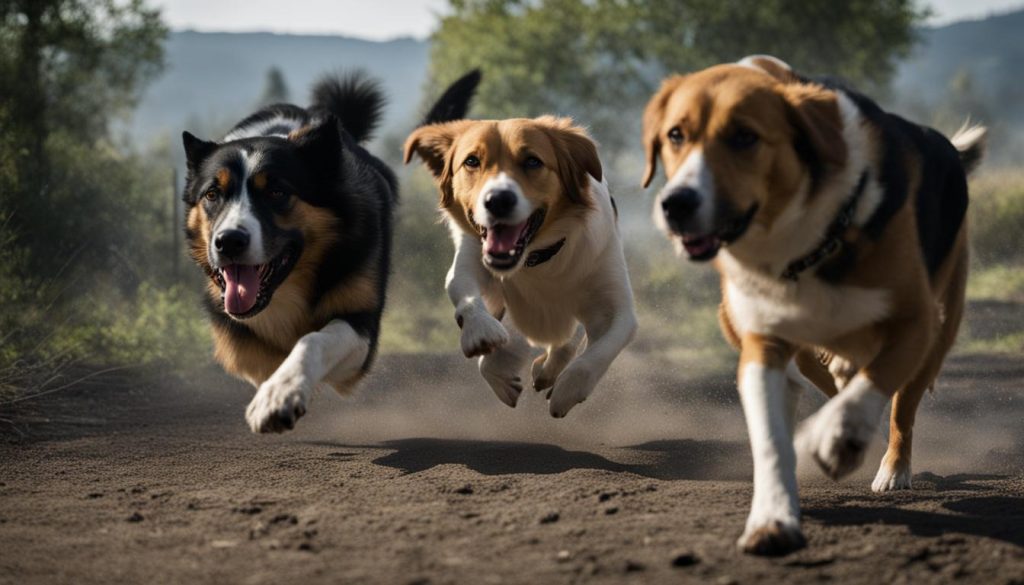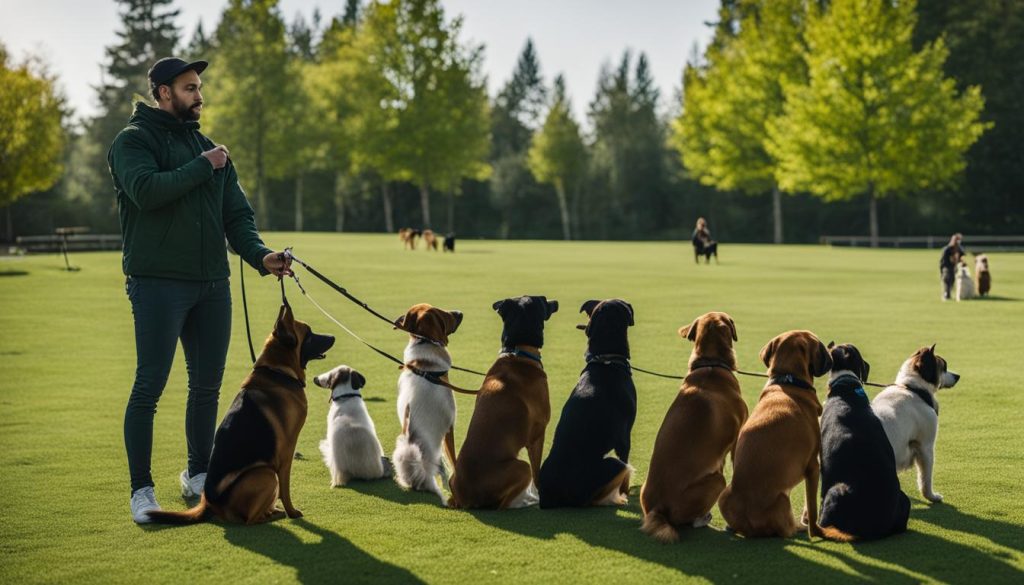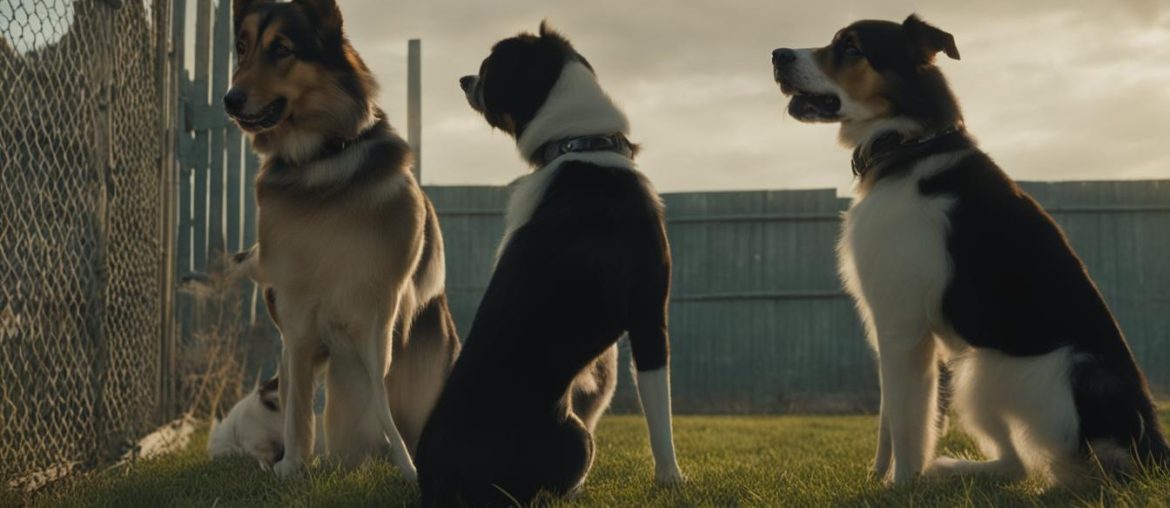Dog fights can be intense and dangerous, so it’s important to know how to recognize and prevent them. Dogs may fight due to resource guarding, fear, frustration, or intolerance. It’s crucial to differentiate between rough play and a real fight by observing body language. Prevention is key, so learn to read your dog’s signs of stress and intervene before a fight happens.
Look out for vocalizing, tail tucking, flattened ears, whale eye, lip licking, excessive sniffing, and pacing as signs of stress. Signs of aggressive intent include a hard stare, lowered head, raised hackles, freezing, and short, sharp tail wags. In the event of a dog fight, never put yourself at risk. Instead, distract the dogs with loud noises, spray them with water, throw a blanket over them, or use objects to physically separate them. If necessary, you can use the wheelbarrow technique with the help of another person. Always seek immediate veterinary assessment after a dog fight.
Key Takeaways:
- Recognize signs of stress and aggressive intent in dogs to prevent fights.
- Distract fighting dogs with loud noises, water spray, or physical objects.
- Avoid putting yourself at risk during a dog fight.
- Seek immediate veterinary assessment after a fight.
- Prevention is crucial in avoiding dog fights – read dog body language and intervene early.
Understanding Dog Fight Types and Triggers

Dog fights can be categorized into three main types: scuffles, scissor fights, and grab fights. Each type involves different levels of aggression and danger. It’s important to understand these types in order to better prevent and address dog fights.
Scuffles are the lowest-contact type of fight, characterized by lots of noise and minimal bite contact. Dogs engaged in a scuffle may growl, snap, and show other signs of aggression, but their bites are generally not severe.
Scissor fights involve dogs attempting to bite each other without establishing a firm grip. These fights can escalate quickly and result in more serious injuries. Dogs engaged in a scissor fight may try to bite the legs, neck, or other vulnerable areas of their opponent.
Grab fights are the most severe type of dog fight. In these fights, dogs bite and hold onto each other, using their strength to overpower their opponent. Grab fights can cause significant injuries, including deep puncture wounds and torn flesh.
Triggers for Dog Fights
There are several triggers that can lead to dog fights. Resource guarding is one common trigger, where dogs become aggressive over food, toys, or other valuable items. Lack of socialization and hierarchy conflicts can also contribute to fights between dogs.
It’s important to address resource guarding early on by teaching dogs to share and providing each dog with their own space and possessions. Avoiding situations that may trigger fights, such as introducing new dogs into the home without proper introductions or allowing dogs to compete over resources, can also help prevent conflicts.
By understanding the types of dog fights and the triggers that can lead to them, dog owners can take proactive steps to prevent fights and create a safe and harmonious environment for their pets.
Safe Techniques to Break Up a Dog Fight

Dog fights can be intense and dangerous situations, and it’s important to know how to intervene safely to protect both the dogs and yourself. There are several hands-off techniques that can be used to break up a dog fight without putting yourself at risk. These techniques include leashed separation and the wheelbarrow separation method.
- Leashed Separation: When a dog fight occurs, one way to safely break it up is by using leashed separation. This involves pulling each dog away from the fight using their leash and physically separating them. It’s important to remember to keep a firm grip on the leash and to move the dogs in opposite directions.
- Wheelbarrow Separation: Another hands-off technique is the wheelbarrow separation method. This technique requires the assistance of another person. One person holds the hind legs of one dog while the other person holds the hind legs of the second dog, and they walk the dogs away from each other. This method helps to prevent redirected bites and keeps the dogs separated.
These hands-off techniques are effective in diffusing the situation and minimizing the risk of further injury. Please be aware that physical intervention should only be used as a last resort, and it’s always best to seek professional help from a veterinarian or a trained animal behaviorist if you’re experiencing frequent dog fights or aggression.
Hands-On Techniques to Break Up a Dog Fight

When it comes to breaking up a dog fight, there are times when hands-on techniques may be necessary. One effective method is the control position, which involves straddling the dogs’ bodies and firmly gripping their necks. This helps to restrict their movements and prevent redirected bites. It’s important to approach this technique with caution and only use it for bite-hold fights.
Another technique that can be used is a deterrent spray. This can help release a dog’s bite hold by spraying the deterrent directly into their mouth. It’s crucial to ensure that the spray is specifically designed for use on dogs and does not contain any harmful ingredients. This method should also only be used in bite-hold fights and should be administered carefully to avoid causing any harm to the dogs.
It’s worth noting that while these hands-on techniques can be effective, they should always be used as a last resort and with the utmost caution. Safety should always be the top priority when intervening in a dog fight. It’s important to remember that professional help should be sought if dog fights occur frequently or if there are underlying behavioral issues contributing to the aggression.
How to Prevent Dog Fights
Preventing dog fights is essential for the safety and well-being of all dogs involved. By following a few key strategies, you can significantly reduce the risk of fights and create a harmonious environment for your pets.
Spaying and Neutering
One of the most effective ways to prevent dog fights is by spaying and neutering your dogs. This helps to reduce aggression and the need to establish hierarchies, which are common triggers for fights. Spaying and neutering can also have other health benefits for your pets, so it’s a win-win situation.
Separate Feeding
Feeding dogs separately is another important preventive measure. Resource guarding, especially when it comes to food, can lead to fights. To avoid conflicts, feed your dogs in separate areas and ensure that no highly desired items are left within reach. This will minimize the chances of possessiveness and fights over food.
Leashing Dogs Outside
When taking your dogs outside, always keep them leashed. This is particularly important in public spaces or areas where your dog may encounter unfamiliar dogs. By keeping your dogs on a leash, you can maintain control and prevent potential conflicts. It also allows you to manage the situation and keep your dog safe from any potential triggers.
| Preventive Measure | Description |
|---|---|
| Spaying and Neutering | Reduces aggression and the need for hierarchy establishment |
| Separate Feeding | Minimizes resource guarding and fights over food |
| Leashing Dogs Outside | Prevents encounters with unfamiliar dogs and maintains control |
Common Triggers for Dog Fights

Understanding the triggers for dog fights is crucial in preventing and managing aggressive behavior. Some common triggers include resource guarding and possessive behavior.
Resource Guarding: Dogs may become protective of their food, toys, or other possessions, leading to fights with other dogs. It is important to address resource guarding early on and manage the environment to prevent conflicts. Keep food bowls separate, remove toys when necessary, and provide dogs with their own space for eating and resting.
Possessive Behavior: Dogs can also become possessive over their owners or personal space, leading to aggression towards other dogs. They may feel threatened when their personal space is invaded or when they perceive other dogs as a threat to their bond with their owners. It is important to recognize signs of possessive behavior, such as growling, lunging, or guarding behavior, and to address it through proper training and behavior modification techniques.
“Resource guarding and possessive behavior are common triggers for dog fights. It is important for owners to be aware of these triggers and take proactive measures to prevent conflicts.”
Table: Triggers and Prevention
| Triggers | Prevention |
|---|---|
| Resource Guarding | Manage resources, separate feeding, and provide individual spaces |
| Possessive Behavior | Training, behavior modification, and managing personal space |
By understanding these triggers and implementing preventive measures, dog owners can create a safe and harmonious environment for their pets. Early intervention, proper training, and professional guidance, if needed, can help address aggressive behavior and minimize the risk of dog fights.
The Dangers of Intervening Physically in Dog Fights

When faced with a dog fight, the instinct to physically intervene can be strong. However, it is important to understand the potential dangers associated with such actions. Attempting to separate dogs with your body can put you at risk of serious injuries, including redirected bites. Dog bites can lead to infections and other complications, requiring medical treatment. Kicking or yelling at the dogs may escalate the situation further, making it even more dangerous.
To ensure your safety and minimize the risk of injuries, it is advisable to use alternative methods to break up a dog fight. Distraction techniques, such as loud noises or objects, can help redirect the dogs’ attention and create a temporary barrier between them. Spraying water or using deterrent sprays can also be effective in releasing a dog’s bite hold without physically intervening. These methods provide a safer approach to diffusing a dog fight while minimizing the risk of harm.
Remember, the priority should always be safety for both yourself and the dogs involved. If you find yourself in a situation where physical intervention seems necessary, it is crucial to prioritize your well-being and seek immediate assistance from others or professional animal control personnel.
“Attempting to physically separate dogs in a fight may result in serious injuries for the humans involved and can escalate the aggression of the dogs. It is important to remember that dogs will be focused on each other during a fight and may not recognize humans as anything other than obstacles.”
Table: Risks of Physically Intervening in Dog Fights
| Risk | Description |
|---|---|
| Redirected bites | When physically separating dogs, they may redirect their aggression towards whoever intervenes. This can result in painful bites and potential injuries. |
| Infections | Dog bites have a high risk of infection due to the bacteria present in their mouths. Infections can lead to complications and require medical treatment. |
| Escalation of aggression | Physically intervening in a dog fight can escalate the aggression between the dogs, making the situation more dangerous for everyone involved. |
| Physical injuries | Humans attempting to break up a dog fight with their bodies are at risk of physical injuries, including bites, scratches, bruises, or more severe wounds. |
Seeking Professional Help for Dog Aggression

If your dog is displaying frequent aggression or is involved in repeated fights, it is important to seek professional help. A veterinary behaviorist is a qualified expert who can assess the underlying causes of your dog’s aggression and provide guidance on behavior modification techniques. They have a deep understanding of canine behavior and can work closely with you to develop a tailored plan to address your dog’s specific needs.
A veterinary behaviorist will conduct a thorough evaluation of your dog’s behavior, taking into consideration their history, environment, and any potential triggers for aggression. They may recommend additional tests, such as blood work or medical examinations, to rule out any underlying medical issues that could be contributing to your dog’s aggressive behavior.
Behavior training is an essential component of addressing dog aggression. A veterinary behaviorist can provide you with tools and techniques to help manage and modify your dog’s behavior effectively. This may include positive reinforcement training, desensitization and counter-conditioning exercises, and implementing management strategies to prevent aggressive incidents.
Remember, seeking professional help is not a sign of failure as a dog owner. It is a proactive step towards ensuring the safety and well-being of both your dog and those around them. With the guidance of a veterinary behaviorist, you can work towards resolving your dog’s aggression issues and fostering a harmonious relationship based on trust and understanding.
| Benefits of Seeking Professional Help for Dog Aggression: |
|---|
| Comprehensive evaluation of your dog’s behavior |
| Identification of underlying medical issues |
| Tailored behavior modification plan |
| Tools and techniques for effective behavior training |
| Management strategies to prevent aggressive incidents |
Wrapping Up
In conclusion, preventing dog fights should be a top priority for pet owners. By understanding the types and triggers of fights, we can take proactive measures to avoid conflicts. It’s important to read our dogs’ body language and signs of stress, intervening early to prevent fights from occurring.
When a fight does happen, it’s crucial to prioritize our safety. Instead of physically intervening, we should use hands-off techniques like distracting the dogs or using objects to separate them. If necessary, seeking assistance from others can help in safely breaking up the fight.
However, if dog fights occur frequently, it’s advisable to seek professional help from a veterinary behaviorist. They can assess the underlying causes of aggression and provide guidance on behavior modification techniques. By prioritizing safety, prevention, and seeking assistance when needed, we can create a peaceful and harmonious environment for our beloved pets.
FAQ
How can I distinguish between rough play and a real dog fight?
You can differentiate between rough play and a real fight by observing body language. Signs of stress, such as vocalizing, tail tucking, flattened ears, and lip licking, suggest a fight may be imminent. Signs of aggressive intent, such as a hard stare and raised hackles, indicate a real fight.
What should I do if I witness a dog fight?
It is important not to put yourself at risk. Instead of intervening physically, you can distract the dogs with loud noises, spray them with water, throw a blanket over them, or use objects to separate them. If necessary, you can employ the wheelbarrow technique with the help of another person.
How should I safely separate dogs involved in a fight?
There are hands-off techniques, such as leashed separation and the wheelbarrow technique, that can be employed to safely separate fighting dogs. Leashed separation involves pulling each dog away and securing them separately, while the wheelbarrow technique requires the assistance of another person to lift the dogs by their hind legs and walk them away from each other.
What are the different types of dog fights?
Dog fights can be categorized into three types: no to low-contact “scuffle,” bite-release “scissor” fight, and bite-hold “grab” fight. Scuffles involve noise and minimal bite contact, while scissor fights involve bite attempts without a firm grip. Grab fights are the most severe, with dogs biting and holding onto each other.
What can trigger a dog fight?
Dog fights can be triggered by various factors, including resource guarding, lack of socialization, and hierarchy conflicts. Resource guarding, such as food or toys, can lead to fights. It is important to address resource guarding early on and avoid situations that may trigger fights.
How can I prevent dog fights?
Preventing dog fights involves spaying and neutering dogs to reduce aggression, feeding dogs separately to avoid resource guarding, and keeping dogs leashed outside to prevent encounters with unfamiliar dogs. Avoiding dog parks if your dog displays possessive behavior and choosing opposite-sex new additions can also help prevent fights.
What are the dangers of physically intervening in a dog fight?
Physically intervening in a dog fight puts you at risk of injury, including redirected bites. It is crucial to prioritize safety and use alternative methods, such as making loud sounds, spraying water, or using physical objects to separate the dogs.
When should I seek professional help for dog aggression?
If your dog displays frequent aggression or is involved in repeated fights, it may be necessary to seek professional help. A veterinary behaviorist can assess the underlying causes of aggression and provide guidance on behavior modification techniques. Basic obedience training can also help improve communication and reduce the likelihood of fights.






